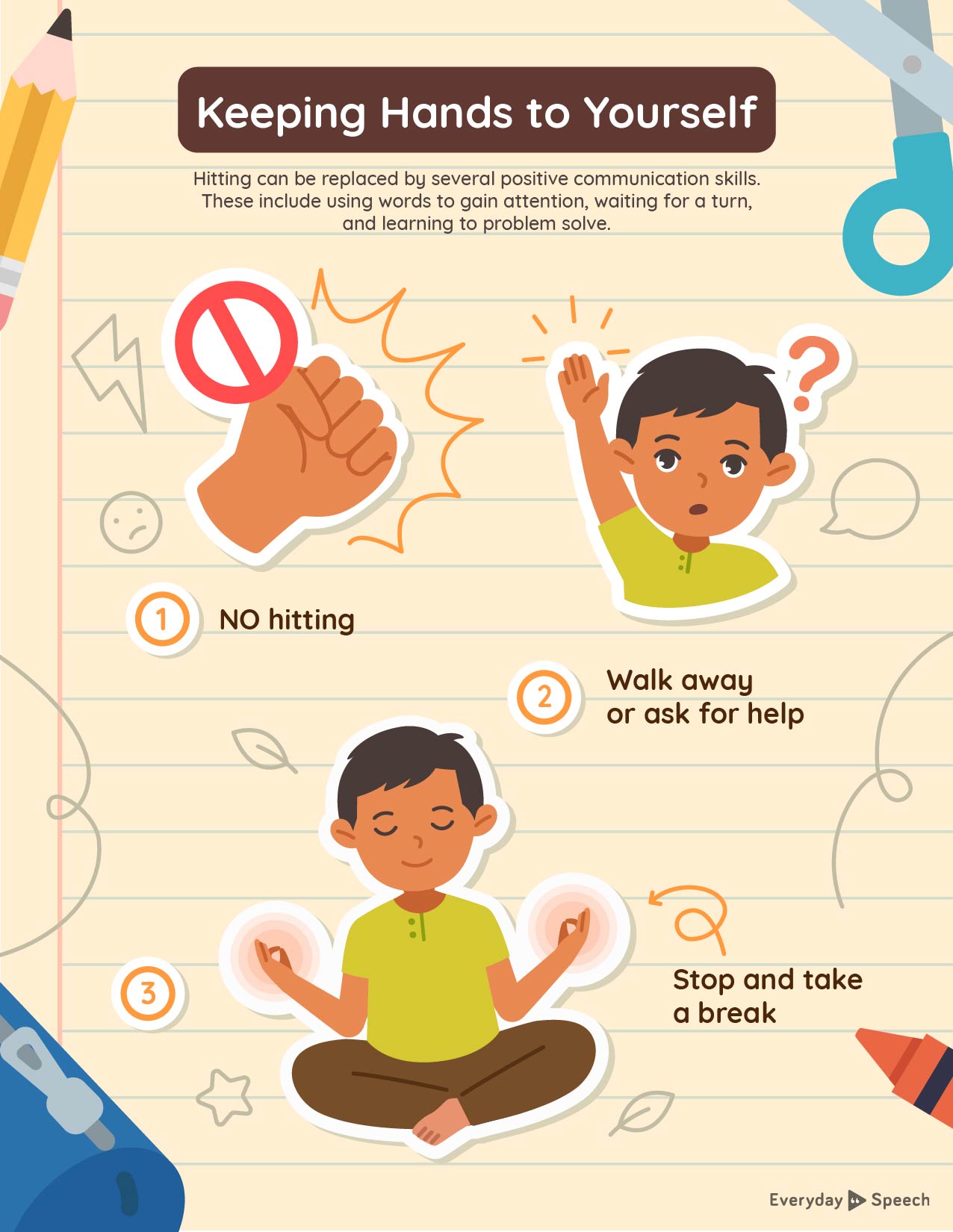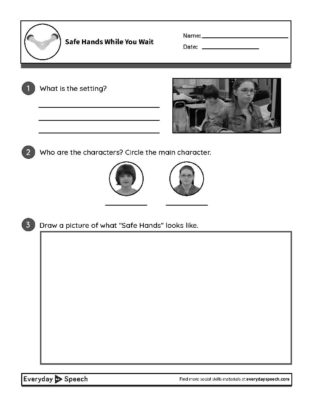Try the no-prep way to teach Keeping Hands to Yourself
Take the prepwork out of teaching essential social-emotional skills with Everyday Speech! Subscribe to access step-by-step curriculum and over 1,000 videos, games, and more.

Preview an SEL skills lesson: Keeping Hands to Yourself

<INTRODUCTION>
Narrator: Sometimes we have to wait for the things we want.
<Animated scene 1 – Boy2 is playing with a toy truck>
Boy1: (looking at Boy2’s truck, internal thought) I want to play with the truck.
Narrator: Waiting means we don’t get to do something right away.
Boy1: (to Boy2) Can I play with that? (points at truck)
Boy2: Sure, when I’m finished.
Narrator: We might not like it when we have to wait.
Boy1: (goes to Boy2 to take the truck) Give me that!
Boy2: (angry) Hey!
Narrator: We might want to just reach out and take something, but we have to keep safe hands. Safe hands means keeping our hands to ourselves. When we take things and put our hands on other people, it can make them feel upset and not want to play with us.
Boy2: I don’t want to play with you anymore.
<Animated scene 2 – Boy2 is playing with a toy truck>
Boy1: (looking at Boy2’s truck, internal thought) I want to play with the truck.
Narrator: Instead of taking something, we can use our words to ask for it. We can say, “Can I use that?” or “Can I have a turn with that?”
Boy1: (to Boy2) Can I play with that? (points at truck)
Boy2: Sure, when I’m finished.
Narrator: If we have to wait, we can make sure we stay calm. Better choices to help us wait are take deep breaths, pick another item, or make a new plan.
Boy1: (brain scan – stay calm options, takes a deep breath, pulls out a book) I’ll read this book until it’s my turn to play with the truck.
<SKILLS>
Narrator: When we have to wait for something, we always use safe hands. We keep our hands to ourselves.
If we’re feeling frustrated, we can use strategies to stay calm. We can pick another toy to play with, take deep breaths, or make a new plan.
If we feel angry, or like we might hurt someone, we stop right away and tell an adult we need a break.
Now, let’s see what happens when Tommy does and does not use safe hands.
<SCENE 1 – Sam is using the computer>
Tommy: (approaches Sam) Hey, can I play?
Sam: You can have a turn when I’m finished.
Tommy: (forces his way to use the computer) But I want a turn right now!
Sam: Hey! It’s not your turn!
Tommy: But I want to play now!
Teacher: (background voice) Tommy, stop that. You’re not getting any computer time today.
Tommy: (sad)
Narrator: Tommy didn’t wait his turn and got in Sam’s space. How do you think this made Sam feel?
Sam: (thought bubble) I don’t want to be friends with Tommy. He makes me so mad.
Narrator: How did Tommy feel when he had to wait?
Tommy: (thought bubble) I wanted to play on the computer! Sam’s been on the computer for 20 minutes already!
Narrator: Sam was feeling mad that Tommy tried to take the computer from her. Nobody likes it when other people touch them. Tommy should have kept safe hands and waited his turn. Let’s watch when Tommy makes a better choice.
<SCENE 2 – Sam is using the computer>
Tommy: (approaches Sam) Hey, can I play?
Sam: You can have a turn when I’m finished.
Tommy: (inner thought) I feel really mad. I want to take the computer. But that’s not okay to do. I’ll just wait my turn. What can I do while I’m waiting? (looks around) I can see if I can read that book for a bit. (sits down quietly and reads a book)
Sam: Hey Tommy. You can use the computer now. (leaves the computer)
Tommy: Thanks! (uses the computer)
Narrator: That time, Tommy used safe hands while waiting for what he wanted. He knew that nobody likes it when other people touch them. Let’s see how this made everyone feel.
Sam: (thought bubble) I’m glad Tommy waited his turn so I could finish playing.
Tommy: I’m gald I used safe hands while I waited my turn. Now both of us are happy.
Narrator: By using safe hands and waiting his turn, Tommy still got to play on the computer and others had good feelings about him. It can be hard to wait, but it will keep others happy and keep us out of trouble if we always use safe hands.
<WHAT DID WE LEARN?>
Narrator: So, what did we learn?
When we have to wait for something, we should:
Use safe hands – we keep our hands to ourselves.
If we’re feeling frustrated, we can use strategies to stay calm. We can pick another toy to play with, take deep breaths, or make a new plan.
If we feel angry, or like we might hurt someone, we stop right away and tell an adult we need a break.
Try Everyday Speech free for 30 days to see all our videos and their companion activities and games!






